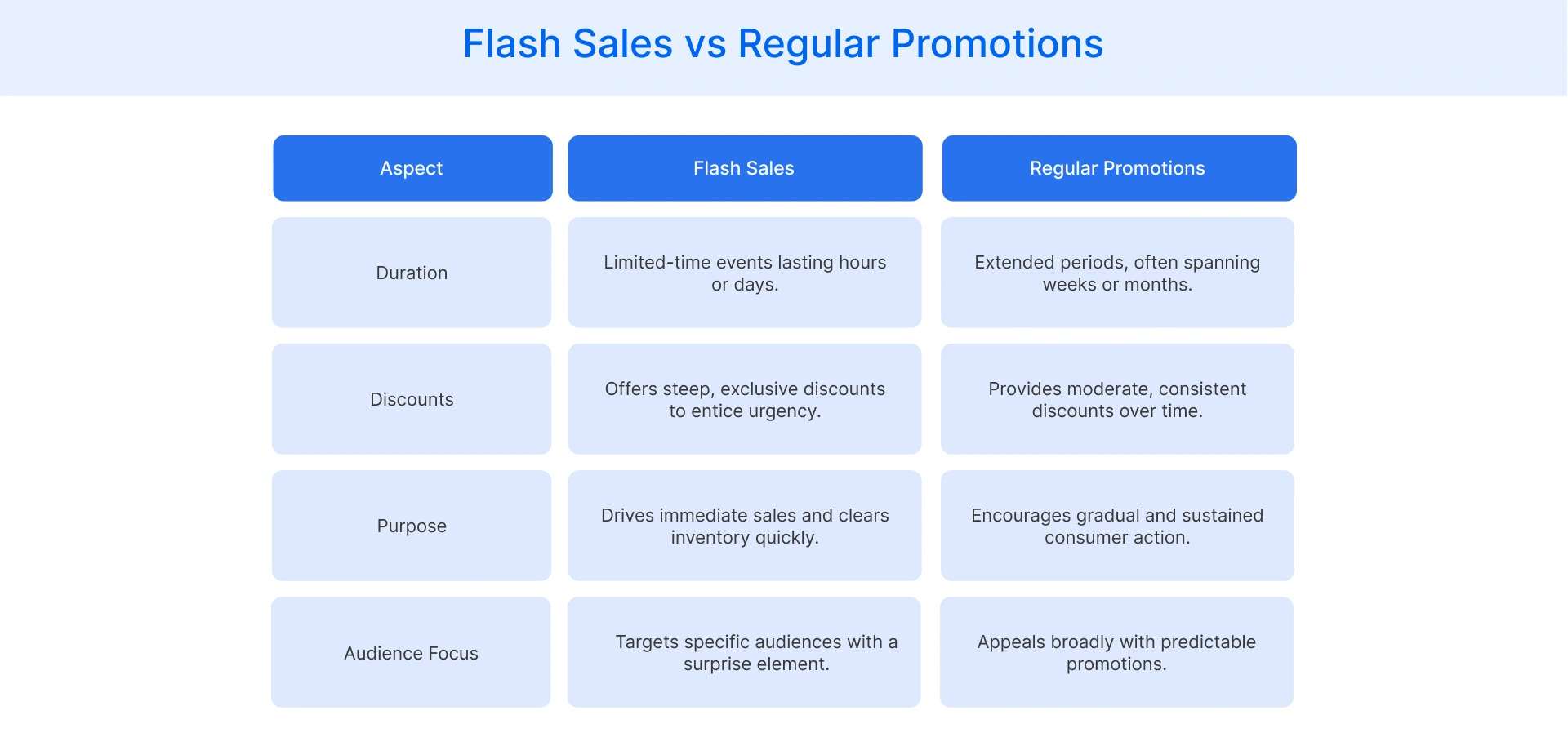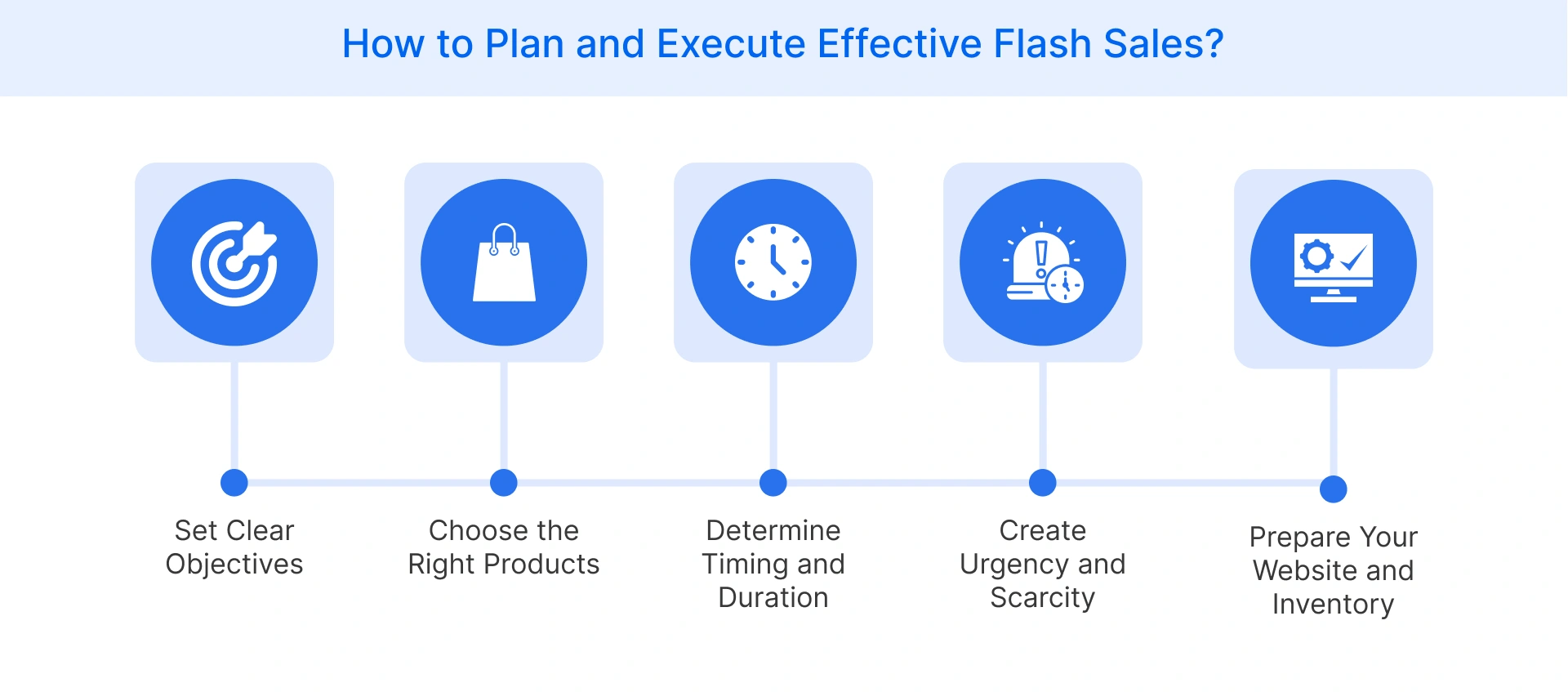Table of Contents
- What are Flash Sales?
- What is the Difference between Flash Sales and Regular Promotions?
- Types of Flash Sales
- Benefits of Flash Sales
- How to Plan and Execute Effective Flash Sales?
- Best practices to manage flash sales
- Tools for Managing Flash Sales
- Conclusion
What are Flash Sales?
Flash sales are time-limited promotional events where retailers offer significant discounts on select products for a brief period. These sales typically last from a few hours to a day, creating a sense of urgency among consumers. Unlike regular promotions, flash sales combine steep price reductions with a short timeframe to drive rapid purchasing decisions.
In e-commerce and retail marketing, flash sales are powerful tools for quickly clearing excess inventory and boosting sales during slow periods.
Flash sales tap into consumer psychology by leveraging scarcity and Fear of Missing Out (FOMO). The limited-time nature of these events triggers impulse buying behaviors, as customers rush to secure deals before they expire. This urgency often leads to quicker decision-making and higher conversion rates compared to standard sales.
While flash sales can significantly impact short-term revenue, their influence on long-term brand perception is nuanced. When executed well, they can enhance brand image by offering exceptional value. However, frequent flash sales may condition customers to wait for discounts, potentially eroding perceived value over time. Striking a balance between offering enticing deals and maintaining brand integrity is crucial for sustainable success in flash sale strategies.
What is the Difference between Flash Sales and Regular Promotions?
Flash sales differ from regular promotions in several key aspects:
- Duration: Flash sales typically last hours or days, while regular promotions can extend for weeks or months.
- Discount Depth: Flash sales often feature deeper discounts to drive immediate action, whereas regular promotions may offer more modest price reductions.
- Customer Engagement: Flash sales create urgency and excitement, leveraging FOMO to boost conversions, while regular promotions focus on steady, long-term customer relationships.
- Inventory Management: Flash sales aim for rapid inventory turnover, requiring careful stock planning, while regular promotions allow for more gradual sales over an extended period.

Types of Flash Sales
Retailers employ various types of flash sales to meet specific business objectives and cater to different customer segments. Each type offers unique advantages and challenges.
Time-Based Flash Sales
Time-based flash sales run for a predetermined duration, typically ranging from a few hours to a couple of days. These sales create a sense of urgency, encouraging quick decision-making. For example, an online fashion retailer might offer a 24-hour ‘Midnight Madness’ sale with 50% off all items.
Inventory-Based Flash Sales
Inventory-based flash sales continue until a specific quantity of stock is sold out. This approach helps retailers clear excess inventory while creating scarcity. An electronics store, for instance, might run a flash sale on 100 units of a popular smartphone model at a 30% discount.
Member-Only Flash Sales
Member-only flash sales are exclusive events available solely to loyal customers or subscribers. These sales reward customer loyalty and incentivize new sign-ups. For example, a VIP sale with early access to new apparel gives subscribers a perk, encouraging repeat business and engagement.
Seasonal or Festival Flash Sales
Seasonal or festival flash sales align with special occasions, holidays, or promotional calendar events. These sales capitalize on increased consumer spending during specific periods. For instance, a Black Friday flash sale with deep discounts on gifts draws crowds ready to spend during the holiday season.
Benefits of Flash Sales
Flash sales offer numerous advantages for retailers, making them a popular strategy in the competitive e-commerce space:
- Increased Sales Volume: Flash sales drive rapid purchasing decisions, leading to a surge in sales within a short period. The limited-time offers create a sense of urgency, encouraging customers to act quickly and potentially make larger purchases than they normally would.
- Customer Acquisition: Exclusive flash sales attract new customers by capturing their interest with limited-time offers. These events introduce the brand to a wider audience, helping retailers expand their reach and establish connections with untapped market segments.
- Enhanced Brand Awareness: The buzz generated by flash sales can significantly boost brand visibility. The excitement surrounding these events often leads to increased social media sharing and word-of-mouth marketing, expanding your brand’s reach to new audiences.
- Efficient Inventory Management: Flash sales provide an excellent opportunity to clear out excess or seasonal inventory quickly. This strategy helps retailers free up warehouse space, reduce storage costs, and make room for new products, improving overall inventory turnover.
How to Plan and Execute Effective Flash Sales?
Developing a successful flash sale strategy requires careful planning and execution. Follow these guidelines to maximize the impact of your flash sales:
Set Clear Objectives
Define specific goals for your flash sale, such as clearing excess inventory, acquiring new customers, or boosting revenue. Establish measurable targets like sales volume, conversion rates, or new email sign-ups. Align these objectives with your overall business strategy to ensure long-term benefits.
Choose the Right Products
Select products that align with your business goals and appeal to your target audience. Consider featuring bestsellers, new arrivals, or seasonal items. Analyze past sales data to identify high-demand products with good profit margins. Balance discounted items with full-price products to maintain overall profitability.
Determine Timing and Duration
Plan the timing of your flash sale strategically, considering factors like your target audience’s online behavior, industry trends, and competing events. Analyze your website traffic patterns to identify peak engagement times. Test different durations, from a few hours to a full day, to find the sweet spot that maximizes urgency without exhausting your inventory.

Create Urgency and Scarcity
Implement tactics to encourage quick decision-making, such as countdown timers, limited stock indicators, and exclusive offers. Use persuasive copywriting that emphasizes the time-sensitive nature of the deals. Consider implementing a waitlist for sold-out items to capture potential customers and gather data for future sales events.
Prepare Your Website and Inventory
Ensure your e-commerce platform can handle increased traffic during the flash sale. Conduct load testing and optimize your website’s loading speed and checkout process. Implement a queuing system if necessary to manage traffic spikes. Accurately forecast demand based on historical data and current trends and prepare sufficient inventory to fulfill orders promptly.
Best practices to manage flash sales
Effective management of flash sales requires a strategic approach to maximize benefits while minimizing potential risks. Here are key practices for successful flash sale execution:
- Segment your audience strategically: Tailor flash sale offerings to specific customer segments based on their preferences and purchase history. This personalized approach can increase engagement and conversion rates.
- Implement a robust inventory management system: Use real-time tracking to prevent overselling and disappointed customers. Consider setting aside a dedicated inventory specifically for your flash sale event.
- Optimize mobile experience: Ensure your mobile platform is fully optimized for quick browsing and seamless checkout. Many flash sale purchases occur on mobile devices during time-sensitive events.
- Leverage email marketing effectively: Send targeted, well-timed emails to build anticipation. Use segmentation to personalize content and increase open rates and click-throughs for your flash sale campaign.
- Monitor and adjust in real-time: Use analytics tools to track performance during the sale. Be prepared to make quick adjustments to pricing, inventory, or promotional tactics based on real-time data.
Tools for Managing Flash Sales
At Flipkart Commerce Cloud (FCC), our solutions drive flash sale success through actionable pricing and inventory strategies. Our Dynamic Pricing Engine leverages AI to monitor market shifts and competitor pricing, enabling real-time adjustments that keep your offers competitive. Complementing this, our Pricing Optimizer lets you set customizable rules, automatically adjusting prices based on inventory levels or demand surges to maximize revenue while protecting margins.
Our comprehensive analytics platform delivers real-time insights, empowering your team to adapt strategies as conditions swiftly evolve. FCC’s inventory management tools provide live stock visibility while predictive analytics forecast demand trends and guide strategic allocation. This dual approach minimizes stockouts and excess supply, ensuring that high-demand products remain available when they matter most. By integrating pricing and inventory management, FCC enables data-driven decisions that enhance customer satisfaction and sustain flash sale performance.
Conclusion
Flash sales have become an integral part of modern e-commerce and retail operations, offering a powerful way to boost sales, clear inventory, and attract new customers. By creating a sense of urgency and exclusivity, flash sales tap into consumer psychology, driving rapid purchasing decisions and increasing conversion rates.
However, the success of flash sales hinges on careful planning, strategic execution, and the use of advanced management and optimization tools. As the e-commerce ecosystem continues to evolve, retailers who master the art of flash sales will be well-positioned to thrive in an increasingly competitive market.
FAQ
Key metrics to track after a flash sale include total revenue generated, conversion rate, average order value, and customer acquisition cost. Also, monitor website traffic, email open rates, and social media engagement during the sale period. Analyze customer feedback and return rates to assess overall satisfaction.
While flash sales can be effective for many products, they work best for items with high perceived value, seasonal goods, or products with strong brand recognition. Luxury items, electronics, and fashion often perform well in flash sales. However, essential or regularly purchased items may not generate the same excitement typically associated with flash sale events.
To prevent stockouts during a flash sale, implement real-time inventory tracking systems and set stock limits for each product. Consider allocating a specific portion of inventory for the sale and using a waitlist feature for popular items. Regularly update your website to reflect accurate stock levels and communicate clearly with customers about product availability.
The ideal duration for a flash sale typically ranges from 24 to 72 hours. This timeframe creates a sense of urgency without exhausting your inventory or overwhelming your operations. However, some retailers find success with shorter periods of just a few hours, especially for high-demand products or exclusive offers.

